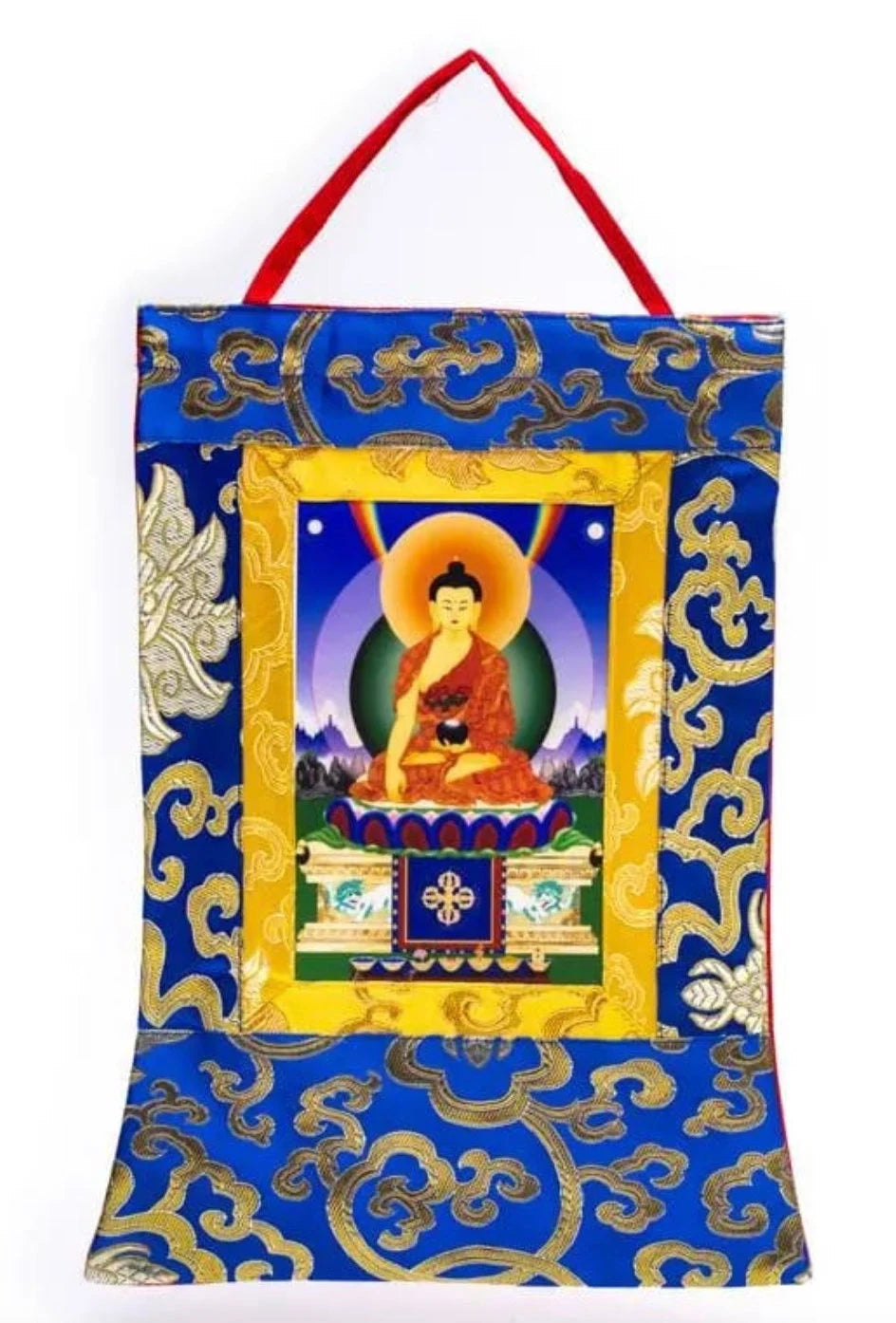Brocade textile thangka, 29x20 centimeters, 5 Buddhas to choose from, superb pieces!
Brocade textile thangka, 29x20 centimeters, 5 Buddhas to choose from, superb pieces!
Couldn't load pickup availability
- ✧─────✧
About the product:
🛕 Name/Type: Small Thangka printed with Buddhas - To decorate any room or hang above an altar. With a fabric surround called 'brocade'.
🌍 Origin: Nepal
📐 ⚖️ Dimensions: 29 x 20 centimeters
⚖️ Weight: 34 grams
🧬 Material: Fabrics - Brocade
📦 Packaging: Individually - Wrapped in paper
🎁 Ideal for giving as a gift or treating yourself!
🌟 Stories and symbols
Thangkas are Tibetan Buddhist religious paintings, executed on canvas or silk, used as tools for meditation, teaching, and devotion. Their history is inseparable from that of Tibetan Buddhism, spanning centuries and challenges, including periods of repression when religious practice was forbidden or dangerous.
📜 Origins and influences (7th–12th centuries)
- 7th century : Buddhism is introduced to Tibet by King Songtsen Gampo , notably through the Nepalese wife Bhrikuti and the Chinese princess Wencheng . This period marks the beginning of the spread of Buddhist arts, including religious paintings.
- 8th century : The Indian master Padmasambhava (Guru Rinpoche) and the pandit Śāntarakṣita establish Tantric Buddhism in Tibet. The first Tibetan Buddhist paintings appear, influenced by Indian and Nepalese traditions.
- 11th–12th centuries : The earliest known thangkas date from this period, illustrating cultural exchanges between Tibet, India, and Nepal. These works served as teaching aids for practitioners, often illiterate, by depicting scenes from the life of the Buddha, bodhisattvas, and mandalas.
🛡️ Thangkas as a means of preservation (13th–19th centuries)
- 13th–14th centuries : Under the reign of Tibetan kings, thangkas became objects of devotion and teaching. Tibetan artists developed their own style, blending Indian, Nepalese, and Chinese influences.
- 16th–17th centuries : Thangkas are used in monasteries for meditation and rituals. They depict deities, spiritual masters, and Buddhist teachings.
- 18th–19th centuries : Thangkas continue to evolve, reflecting political and religious changes in Tibet. They serve both as aids for meditation and as a means of preserving Buddhist tradition in the face of external challenges.
🧭 Thangkas as symbols of resistance (20th century)
- 1950 : The Chinese invasion of Tibet leads to the destruction of many monasteries and the persecution of Buddhist practitioners. Thangkas, as religious representations, are threatened.
- 1959 : The exile of the Dalai Lama and thousands of Tibetans marks a turning point. Thangkas become symbols of cultural and spiritual resistance. Tibetan artists in exile, particularly in India, preserve and transmit this sacred art.
- Today : Thangkas continue to be created and studied, both inside and outside Tibet. They are recognized as intangible cultural heritage, testifying to the resilience and richness of Tibetan Buddhism.
🎨 Artistic and spiritual characteristics
- Iconography : Each thangka follows precise rules for representing deities, with specific proportions and attributes.
- Symbolism : Colors, shapes, and patterns have deep meanings, linked to Buddhist teachings.
- Function : Thangkas serve as aids for meditation, teaching, and devotion. They are used in rituals, ceremonies, and spiritual practices.
🕊️ Conclusion
Thangkas are much more than just works of art. They embody the history, spirituality, and resilience of the Tibetan people.
Over the centuries, they have endured hardships, testifying to the strength of the Tibetan Buddhist tradition in the face of adversity.
Even today, they continue to inspire and guide practitioners, while preserving a precious cultural heritage.
- ✧─────✧
A question? A comment? | Order and delivery information
A question? A comment? | Order and delivery information
⋯⋯⋯⋯⋯⋯⋯⋯⋯⋯⋯⋯⋯⋯⋯⋯⋯⋯⋯⋯
📞 Customer service available from Tuesday to Saturday , from 10am to 7pm (French time)
- 🇫🇷 From France: 06 51 85 38 18
- 🌍 From abroad: +33 6 51 85 38 18
- 💬 Live chat: via the bubble in the bottom right corner of your screen
- 📧 Email : available 24/7 – we respond quickly!
⋯⋯⋯⋯⋯⋯⋯⋯⋯⋯⋯⋯⋯⋯⋯⋯⋯⋯⋯⋯
🔖 Order today and receive your package within 2 to 10 days depending on your continent.
💳 Secure payment & certified by SSL encryption 🔐
↩️ Returns & exchanges possible within 14 to 30 days after receipt.
🌍 Shipping costs are calculated automatically based on your shipping address at checkout.
📦 Country of shipment: France 🇫🇷
Share















